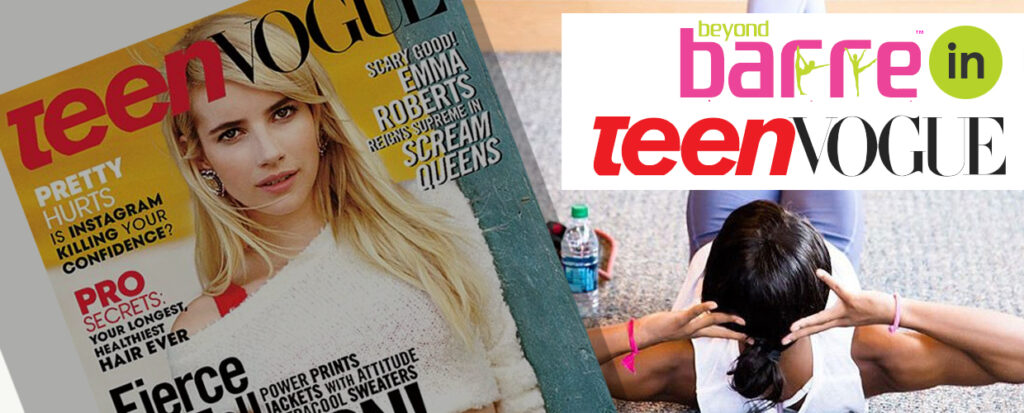Saved by the barre. Kate Parrish | Oct 30, 2015 | Teen Vogue I struggled to establish a fitness routine most of my life. I’ve joined the YMCA three different times. I’ve tried personal training, hip-hop classes, spin, Pilates, several different types of yoga, running, walking, hiking, and just thinking really hard about working out while lying in bed. Nothing ever stuck. I’d get bored, or lazy, or too self-conscious, and quit. But there was always a quiet desire in me to keep trying, to look for something that would go beyond physical fitness to something that felt more like a physical act of gratitude, something that challenged my mind and my body while thanking it for carrying me through the day.
After sharing with a friend that I wanted to get back into a fitness routine, she suggested I try a barre class. As soon as I heard the word barre, I immediately flashed back to cheerleading and dance routines I couldn’t remember, leotards that wouldn’t stay in place, and girls with bodies that didn’t look like mine. I was anything but convinced this would be the exercise program for me, but I was willing to give it a try.
Today there seem to be endless variations of barre classes with hundreds of studios dotting the United States and extending into Canada. There’s Pure Barre, Physique 57, The Bar Method, Barre3, Beyond Barre, and BarreAmped, just to name a few. Each puts its own spin on the barre-based, low-impact, high-intensity trend, combining elements of ballet, yoga, Pilates, strength training, and dare I say, a touch of step aerobics.
I signed up for a class, finding one around the corner from work. The only rules for class were no midriffs or shorts, and to wear socks. I learned quickly that newcomers are easy to spot because they’re usually not wearing the no-slip socks. My first class was overwhelming. There was a lot of information to absorb quickly, but nothing so complex that even my dance class-scarred brain couldn’t handle. After that first class, when 55 minutes felt like fifteen, I committed to 10 classes no matter what. It was the first time I’d had fun working out in years. And with each class I attended, the instructions, terminology, and pace of class started to make more sense.
While each brand of barre class is different — modifying the movements, the order of muscle groups worked, the terminology and props used — most center around the idea of using small, isometric movements to gradually fatigue one muscle group at a time, focusing on hips, thighs, the seat, abs, and arms. These tiny movements, like one-inch pulses on tip-toes, fatigue the muscles, making them stronger without bulking them up in the same way that larger muscle movements, like squats, can. They also encourage a more intentional mind-body connection; the smaller the movement, the deeper the focus.
The ballet barre is used in sections of class (but not all of it) to maintain balance, challenge the core, or to go deeper into certain movements. Fast-paced, beat-driven music drives the class and motivates you through the tough spots. And there are tough spots. The goal is to reach muscle fatigue in each muscle group worked. When that happens, muscles won’t just burn, they’ll shake. In early classes, I used to get embarrassed when my legs started shaking. Now I work to make that happen, knowing it means I’m challenging my muscles to change and leaving nothing on the table. In those moments when I’m shaking and I want to quit, I know my mind is working harder than my body. The physical game becomes the mental game. Stretching typically follows each section of class, improving flexibility by lengthening muscles while they’re still warm.
I noticed changes in my body within the first 10 classes. I felt taller and leaner. I noticed lines in my arms where there weren’t any before. My head felt clearer. And this strange realization began to manifest: when I make time for myself, more time appears for others. I have more energy. I sleep better. I want to eat better because I feel better. When I feel anxious or stressed, I leave class with a new sense of strength that whatever it is, it will be okay.
As 10 classes turned into 20, 20 into 100, and 100 into several hundred, I realized I’d created the exercise routine I’d always wanted for myself, one that made me feel confident and strong, intentional and grateful. I’ve quit every other kind of exercise I’ve tried except for barre classes. Physically, I am challenged each class to work harder, go deeper, to make each movement as small and precise as possible. Mentally, I have to go somewhere else in my mind. I have to push out the demands of the day and bring my attention inward to the muscles I’m working, the beat, and my breath. The challenges of class, both physical and mental, require me to focus only on what’s in front of me, not what’s waiting outside the classroom door.
I treat exercise today like I would any important appointment: I schedule it and I don’t cancel. I make an investment with my time and my money. Individual classes typically range from $20-$30 per class, but many studios offer discounted packages and student rates. Personally, I’m more likely to follow through when there is a larger financial commitment on the line.
It took me years to find a type of exercise that I liked, and barre classes certainly won’t be the answer for everyone, just like so many other kinds of exercise weren’t the answer for me. The point is to continue to seek out ways to honor ourselves — our bodies and our minds — and to give ourselves an intentional space where we can break from the challenges of everyday life, enabling us to come back to them stronger.
Source: http://www.teenvogue.com/story/barre-classes-setting-fitness-routine
]]>

